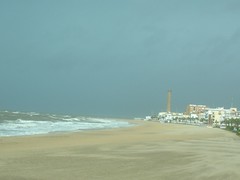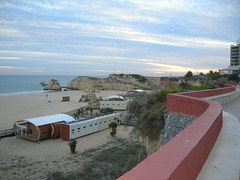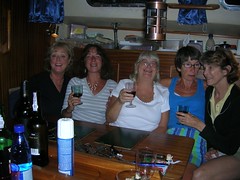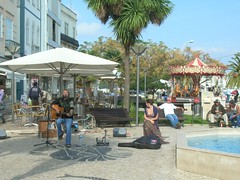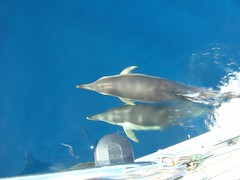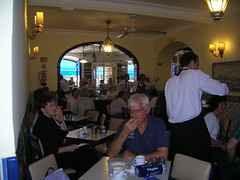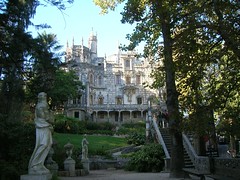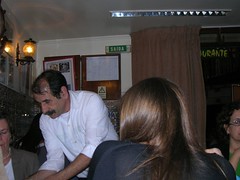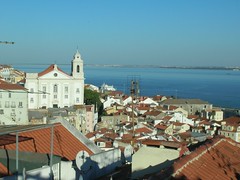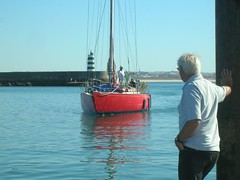THE FADO EVENING, LISBON
According to our guide book Fado, like blues, is a musical form which “owes much to the concept known as saudade, meaning a longing both for what has been lost, and for what has never been attained … “. This sounded like it could be a fun evening so we decided, while in Lisbon, the home of Fado, to go to a performance. Our guide book counselled us to avoid the slick tourist presentations and to seek out fado vadio, itinerant fado in humbler restaurants and bars in order to enjoy a more authentic musical experience.
We found an area of downtown Lisbon where the narrow winding streets were full of small family run restaurants all offering an evening of fado. The problem of choosing which restaurant to go to was solved by the restaurant choosing us. Outside the establishment the grandfather of the family, a charming man of some eighty years, accosted passersby and without the benefit of a common language, but with great curtesy and politeness firmly ushered them through the door. Indeed, during the course of what proved to be a long evening we only saw one couple who wandered in voluntarily. They left shortly afterwards. Somewhat surprisingly the staff seemed to be acquired in the same way; a young girl was accosted and, rather reluctantly I thought, propelled into the restaurant where she donned apron and proceeded to wait on table.
Without doubt the star turn of the evening was the waiter; a character who bore more than a passing resemblance, both physically and in terms of competence, to Manuel in Fawlty Towers. He muddled orders, forgot things and generally created chaos with great energy and good humour simultaneously looking worried to death. However, if he was Manuel the young girl proved to be Polly; calmly and with great resourcefulness sorting out all the problems.
In due course the Fado musicians arrived, or at least two of them did; the singers, two male and one female turned out to be none other than the husband and wife who owned the restaurant and the grandfather figure who we had met outside. Indeed, the old man proved equally skillfull in propelling people through the door when working inside as when working outside. It was during one of his numbers that Sheila, who is generally not one to cut and run, lent across the table and with a note of desperation in her voice asked whether we had to stay till the very end.
The instrumentalists consisted of a guitarist and someone who played a strange 12 string sort of mandolin called the English Guitar which had its own unique Fado tuning. These two musicians were very skilled and quite enjoyable to listen to. Unfortunately, the same could not be said of the vocalists, although they would have perhaps done better to have concentrated on the job in hand instead of multi-tasking. The middle-aged male singer obviously aspired to be an electrician – he changed the light bulb in the ladies toilet and fiddled with the fuse box inbetween numbers. His wife, who made a noise somewhat reminiscent of a cat having one of its legs amputated with a blunt saw, multi-tasked by passing plates of food, drinks and lighting candles (perhaps she suspected that her husband’s electrical skills matched his musical ability) on tables. The high point of her performance for me was when the obese, toothless, cook attempted to squeeze past my chair all too briefly depositing one huge breast in each of my ears; mercifully drowning out the Fado singing. I would not say that the male vocalist was hopeless; I think that if he had the right tuition and really applied himself in several years time he might make a reasonably competent electrician.
Fortunately, the performance was presented in twenty minute musical blocks after which there was a twenty minute recovery break (necessary for the audience rather than for the performers). However, we noticed that one of the instrumentalists would take his mandolin and rush off up the street during these breaks. One could be forgiven for forming the suspicion that he was simultaneously performing in another nearby restaurant. This reminded me of when I worked for a college. A fellow lecturer had perfected the technique of teaching two classes (different subjects) at the same time, thus fulfilling his contractual teaching obligations in half the required time. He would say a few words of wisdom in front of one class and then leave them to ponder the matter while he sprinted to his other class (often located on a different floor of the same building and sometimes even in a different building) where he somewhat breathlessly gave them something to think about before sprinting back. It always surprised me that given the rather top heavy management structure in colleges (the lecturer in question had above him a senior lecturer, a principal lecturer, a head of school, an assistant dean, a dean, several assistant principals, a vice-principal and rather like the Lord Chancellor, in Dickens Bleak House, a principal ultimately presiding over this mountain of self-important incompetency) that no-one apparantely thought that this double teaching was in anyway unfair to either students or taxpayers.
But I digress; back to the fado evening. During one of the breaks the male vocalist/electrician visited each table and attempted to sell a CD of his greatest Fado hits; he was as successful as John Prescott would be trying to recruit members for weight watchers. Like most other people in the restaurant we made an early exit.
Well we certainly achieved what we set out to do i.e. avoid a slick performance and the evening did leave me with a longing for what has never been attained.
